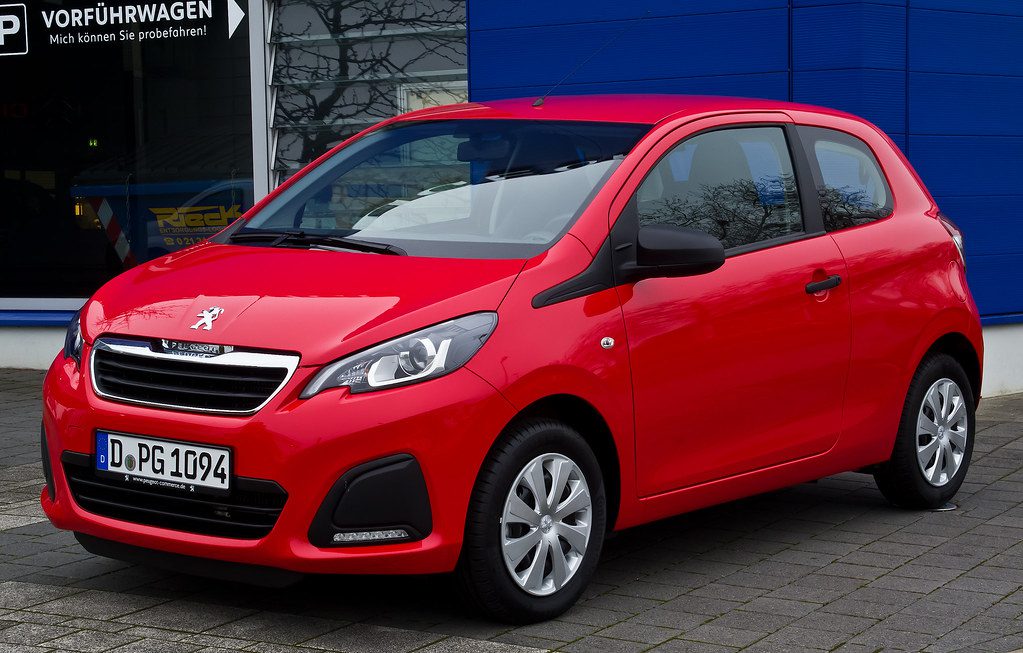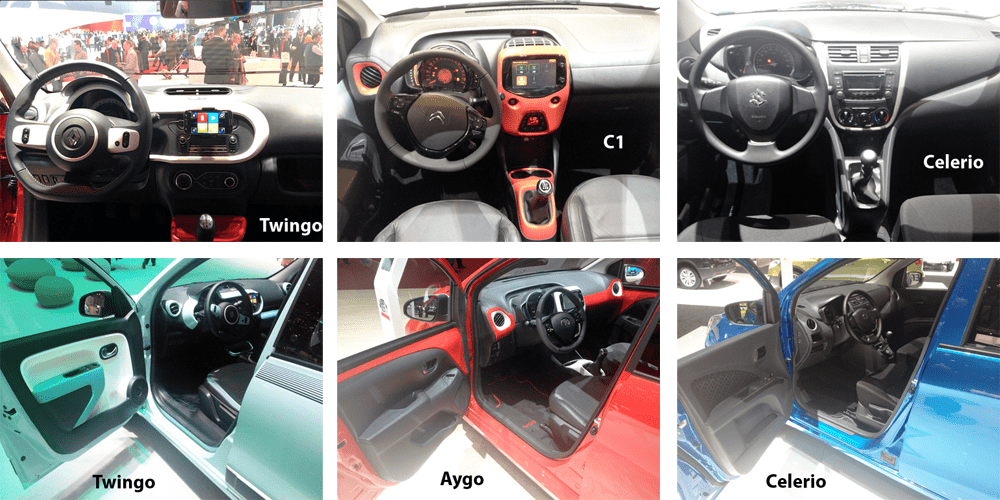The Fiat 500 has been and still is a great success story. It has been on the market for almost 7 years already, its exterior design hasn’t been changed much since, but sales have remained firm and have actually increased again in 2013, and also in 2014 so far, outselling the once very popular Fiat Panda. Besides the obviously appealing design, its success may also many ways buyers can customize the exterior and interior of the car, a trend that has caught the attention of other automakers.
Renault Twingo
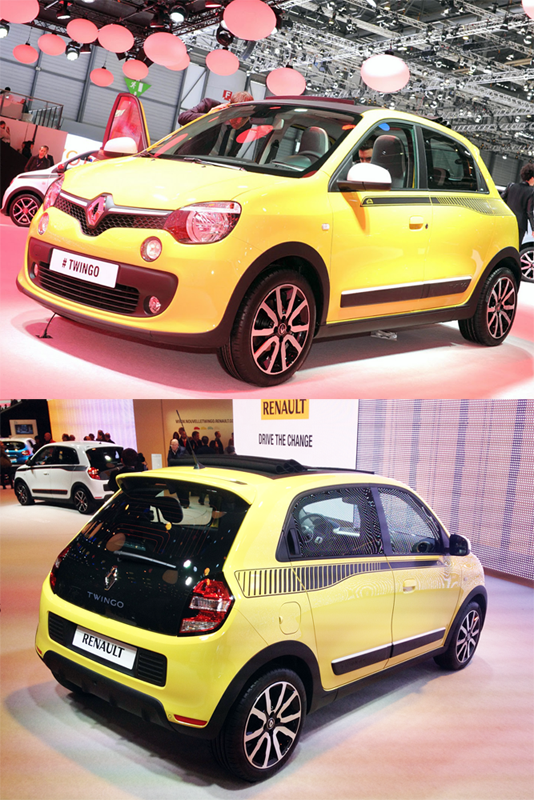 Renault claim the new, third generation Twingo was inspired by the 40-year old Renault 5, but after talking to some visitors on the show floor at the Geneva International Autoshow, it shouldn’t come as a surprise that most people find the Twingo very similar to the Fiat 500. And it’s not only because of the design, but also because the cars on the Renault stand all have been personalized with striping, colored dashboard and steering wheel accents and different sporty wheels.
Renault claim the new, third generation Twingo was inspired by the 40-year old Renault 5, but after talking to some visitors on the show floor at the Geneva International Autoshow, it shouldn’t come as a surprise that most people find the Twingo very similar to the Fiat 500. And it’s not only because of the design, but also because the cars on the Renault stand all have been personalized with striping, colored dashboard and steering wheel accents and different sporty wheels.
Also appealing to the younger target audience are the connectivity options: Renault offers customers an “R & Go” app that can link an Apple or Android smartphone to the Twingo’s multimedia system for 3D-navigation, hands free calling, music and trip computer. The smartphone can then be mounted on the dashboard at eye level and operated through a simple four-icon menu.
Citroën C1, Peugeot 108, Toyota Ago
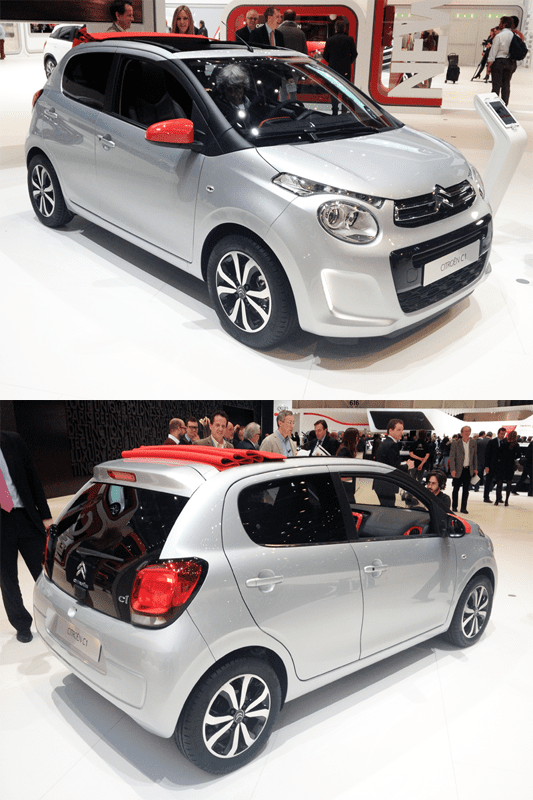 Similar to the Twingo (and the Fiat 500), the new Toyota Aygo is highly customizable, both inside and outside. The Aygo has a choice of different colors for its X-shaped grille and other exterior accents on the bumpers and doors, and also for its dashboard and center console. Besides that, the Aygo and its French siblings Citroën C1 and Peugeot 108 can be equipped with an optional full-sized sliding canvas roof as well and offer similar connectivity options. The Citroën C1, for example, will be available with a 7’’ touchscreen grouping radio, telephone, video player and trip computer. Drivers can copy smartphone content onto the 7’’ touch screen for easy display and control through an exchange app, which allows them to use several driving-compatible smartphone apps from the 7’’ touchscreen: navigation, telephone, address book, music etc.
Similar to the Twingo (and the Fiat 500), the new Toyota Aygo is highly customizable, both inside and outside. The Aygo has a choice of different colors for its X-shaped grille and other exterior accents on the bumpers and doors, and also for its dashboard and center console. Besides that, the Aygo and its French siblings Citroën C1 and Peugeot 108 can be equipped with an optional full-sized sliding canvas roof as well and offer similar connectivity options. The Citroën C1, for example, will be available with a 7’’ touchscreen grouping radio, telephone, video player and trip computer. Drivers can copy smartphone content onto the 7’’ touch screen for easy display and control through an exchange app, which allows them to use several driving-compatible smartphone apps from the 7’’ touchscreen: navigation, telephone, address book, music etc.
This smartphone connectivity should appeal to the gen-Y car buyers, but whereas the options for customization look great in sales brochures and may even help these vehicles to get a “hip and trendy” image, I believe most customers will simply opt for a more moderate color scheme, as they may be afraid of resale value for a vehicle that is too personalized. Especially with things like (roof) stickers and bright colored mirror caps or bumper strips: how many Mini’s and Fiats 500 do you see with this kind of decoration? Besides that, not all customers prefer a car to be as playful and colorful, and that’s where Suzuki comes in with the new Celerio.
Suzuki Celerio
The Celerio is the replacement to the Suzuki Alto, and whereas the Twingo and Kolin sisters are developed purely for the European market, the Celerio will be sold mostly India, one of the Alto’s biggest markets and production base, an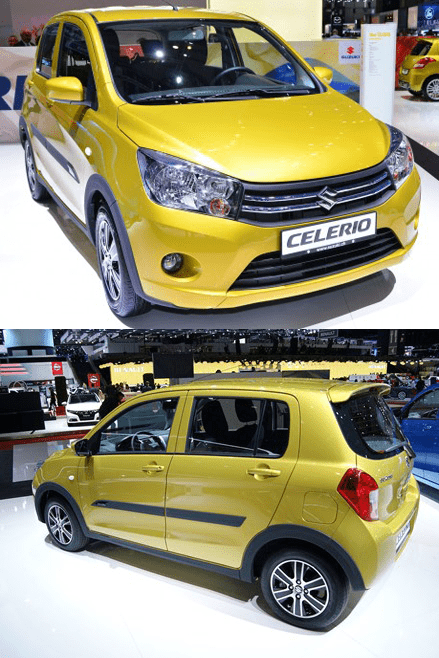 d Japan. The difference in target markets is noticeable inside and outside, as the Celerio sets itself apart from the other newly introduced minicars by being much less frivolous and more functional. The Celerio doesn’t aspire to be hip and trendy, it wants to offer no-frills basic transportation with good fuel economy and a spacious interior.
d Japan. The difference in target markets is noticeable inside and outside, as the Celerio sets itself apart from the other newly introduced minicars by being much less frivolous and more functional. The Celerio doesn’t aspire to be hip and trendy, it wants to offer no-frills basic transportation with good fuel economy and a spacious interior.
As a result, Suzuki claims the largest interior and luggage space of the segment, as well as class-leading fuel economy. This should appeal to the sensible and thrifty minicar buyer, the same people who used to buy the Alto. It also has a much narrower and taller stance than its competitors-to-be, which should appeal to senior citizens looking for a high seating position and easy entrance, but is opposed to the current trend for European-style minicars. For example, the Hyundai i10 used to be designed as a tall senior-citizen transportation, but the new generation is much less hard on the eyes. With its all-black dashboard, the Celerio has a more serious and less frivolous interior, but it makes it look and feel more like a budget car compared to the other new entrants in the segment, which have made great inroads in exterior and interior design. It’s main competitors will be the Mitsubishi Space Star and perhaps the Chevrolet Spark, which are also vehicles in Asia, for the Asian market. Both are not very successful in the European minicar segment, which may be an indication for the Celerio’s fate.
Click to enlarge
The Twingo and 108-Aygo-C1 triplets should appeal to a younger crowd, in search of a fashionable small car that they can customize for even more individuality. Renault, Toyota and Peugeot-Citroën have realized this is a very appealing type of customer, as they are less price sensitive and tend to spend hundreds to sometimes thousands of euro’s on top of the base price to dress up the vehicle to their liking and for technology gadgets. But these customers have an ever-growing supply of cars to choose from. Let’s just hope there are enough of these buyers for everyone to be able to take a piece of this cake, it will make European streets more attractive to look at.

